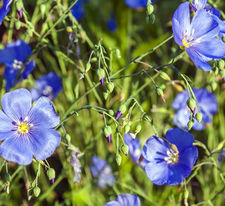Russian flax
Subsidies
The Ministry of Agriculture of Russia, starting in 2018, allocates funds from the federal budget to flax-producing farms in the form of subsidies in the amount of 10 thousand rubles per hectare of cultivated flax, as well as subsidies from regional (republican) budgets, taking into account the capabilities of the regions (2–6 thousand rubles/ha and more). In addition, it is planned to allocate federal funds to stimulate the quality of flax produced by flax-growing farms. Quality subsidies will be provided for each ton of fiber raw materials produced.
Flax-growing farms, flax plants with the status of an agricultural producer and sowing flax will be subsidized. The totality of the allocated per-hectare subsidies and the stimulation of the quality of the received flax for obtaining high numbers of long flax fiber (№ 11, № 12, № 13) during processing, it will also be additionally subsidized. At the present stage, this will ensure profitability of at least 35% and 40%, and lay the prospect of a consistent increase in flax production, strengthening the material and technical base of flax sowing.

"This subsidy is provided within the framework of a project initiated by the Ministry of Agriculture of the Russian Federation for the development of flax growing and deep processing of flax raw materials," comments the President of the Russian Union of Textile and Light Industry Entrepreneurs (SOYUZLEGPROM) Andrey Razbrodin. Let me remind you that the Russian Union of Textile and Light Industry Entrepreneurs, figuratively speaking, stood at the origins of this project, because the enormous opportunities for the comprehensive development of this industry, although traditional for Russia, have not been used for many years. As a result, import substitution for finished flax products is difficult.
The fact is that in many countries this industry is actively developing due to the growing demand for natural raw materials. In addition, an increasing range of innovative products from the chemical industry, the construction industry, the automotive industry, pharmaceuticals and a number of other industries contains products of deep processing of flax. Such a trend is typical for Russia, but it is not the first year that the stumbling block here is the low quality of domestic raw materials and the shortage of modern processing capacities.

The subsidy is provided for flax farms in 18 subjects of the Federation, where flax is cultivated on an industrial scale. But the level of this subsidy is still low. It is at least 4 times lower compared, for example, with China, Turkey, Argentina, Italy, Scandinavia (that is, with the total level of state support in these countries per one "flax" hectare). These same countries/regions are the main suppliers in the Russian Federation of high-quality flax fiber and products of its deep processing.
The potential of Russian flax
At the beginning of the XX century, Russia annually exported flax products, including flax fiber, in the amount of 250 million rubles, which, translated into the modern exchange rate, is about 300 billion rubles, which, in turn, is comparable to the cost of 50% of the grain produced in the country. Currently, Russia to a certain extent has the ability to export flax fiber, as well as linen fabrics to the external (world) market. Flax fiber supplies are carried out primarily to China. Linen fabrics are also exported abroad. During 2013 and 2015, the export deliveries of linen fabrics averaged about 6 million square meters per year. At the same time, due to China's accession to the WTO and a number of other circumstances, there has been a decrease in the supply of linen fabrics to the foreign market (over the past 10 years - 6 times). Despite this, Russia still has the opportunity to use its untapped export potential on the world market. To do this, it is necessary to improve the quality of the flax products produced and the linen fabrics and flax goods produced from it. It is necessary to significantly expand the range and increase the volume of products obtained in the process of deep processing (flax cellulose, flax wool, surgical linen thread, etc.).

"First of all, long-term state support, direct and indirect, of the entire flax complex is required," believes Andrey Razbrodin. "For technological and economic reasons, it is impossible to provide selective support either to flax growing or to the processing segment. The sector of production of linen yarn and related products requires special attention. So far, only five constituent entities of the Federation have these capacities, first of all. And secondly, they have been in need of modernization for a long time.

Russia has the largest areas for the development of flax growing. There are also many developments of domestic innovative products containing flax in their composition. But for some reason, the flax-growing segment and flax processing in general have been stagnating in the last Soviet years. While in these countries, as well as in Belarus, the state has increased and continues to increase support for the flax complex and its technological base. As a result, today Belarus is the same in terms of acreage (although its entire territory is only 4 Moscow regions) at least it is not inferior to Russia. The technological base of the flax complex is also actively developing in Belarus. In this regard, I believe that cooperation with Belarusian partners in all segments of the industry is advisable.
To be continued
Text: Svetlana Michan
Photo: shutterstock











